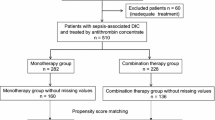Abstract
Purpose
Recombinant thrombomodulin (rTM) has been available in Japan since 2008, but there is concern about its association with postoperative hemorrhage. The efficacy and safety of rTM were examined in patients with disseminated intravascular coagulation (DIC) caused by a septic condition after gastrointestinal surgery.
Methods
Forty-two patients were emergently admitted to the intensive care unit after emergent gastrointestinal surgery in Kyushu University Hospital from May 2008 to April 2013. Of these patients, 22 had DIC (defined as an acute DIC score ≥4). All but three patients received treatment with gabexate mesylate (GM) (n = 9) or rTM (n = 10). The causes of sepsis were peritonitis with colorectal perforation, anastomotic leakage, and intestinal necrosis. Acute DIC score, sepsis-related organ failure assessment score, platelet count, and a variety of biochemical parameters were compared between rTM and GM recipients after treatment administration.
Results
There were no significant differences between the groups for any parameter except C-reactive protein levels. The CRP level tended to be lower in the rTM group than in the GM group. Acute DIC score in the rTM group resolved significantly earlier than that in the GM group. No patient stopped the administration of rTM because of postoperative bleeding.
Conclusion
rTM may be an effective therapeutic drug for the treatment of septic patients with DIC following emergent gastrointestinal surgery.





Similar content being viewed by others
References
Kosugi C, Yasuda H, Koda K, et al. Evaluation of the usefulness of APACHE II, SOFA and POSSUM scores for the postoperative risk assessment in patients with colorectal perforation. JAEM. 2009;29(5):697–702.
Chin S, Fugita R, Kawa Y, et al. Prognostic factors and postoperative complications in patients with colorectal perforation. Jpn J Gastroenterol Surg. 2010;43:1007–13.
Saito H, Maruyama I, Shimazaki S, et al. Efficacy and safety of recombinant human soluble thrombomodulin (ART-123) in disseminated intravascular coagulation: results of a phase III, randomized, double-blind clinical trial. J Thromb Haemost. 2007;5:31–41.
Aikawa N, Shimazaki S, Yamamoto Y, et al. Thrombomodulin alfa in the treatment of infectious patients complicated by disseminated intravascular coagulation: subanalysis from the phase 3 trial. Shock. 2011;35:349–54.
Van de Wouwer M, Collen D. Conway EM: Thrombomodulin-protein CEPCR system: integrated to regulate coagulation and inflammation. Arterioscler Thromb Vasc Biol. 2004;24:1374–83.
Tamura Y, Hirado M, Okamura K, Minato Y, Fujii S. Synthetic inhibitors of trypsin, plasmin, kallikrein, thrombin, C1r- and C1 esterase. Biochim Biophys Acta. 1977;484:417–22.
Taenaka N, Shimada Y, Hirata T, Nishijima MK, Takezawa J, Yoshiya I, Kambayashi J. Gabexate mesilate (FOY) therapy of disseminated intravascular coagulation due to sepsis. Crit Care Med. 1983;11:735–8.
Ito T, Kawahara K, Okamoto K, et al. Proteolytic cleavage of high mobility group box 1 protein by thrombin-thrombomodulin complexes. Arterioscler Thromb Vasc Biol. 2008;28(10):1825–30.
Abeyama K, Stern DM, Ito Y, et al. The N-terminal domain of thrombomodulin sequesters high-mobility group-B1 protein, a novel antiinflammatory mechanism. J Clin Investig. 2005;115(5):1267–74.
Eguchi Y. Efficacy of recombinant thrombomodulin in antithrombin substitution-resistant septic disseminated intravascular coagulation: results of a pilot study. J Jpn Soc Surg Infect. 2010;7(2):143–8.
Yada N, Nishio K, Seki T, et al. Therapeutic effect of recombinant thrombomodulin on the hemostatic and inflammatory response in patients with septic DIC. J Jpn Assoc Acute Med. 2011;22:749–57.
Nakahara K, Okuse C, Adachi S, et al. Use of antithrombin and thrombomodulin in the management of disseminated intravascular coagulation in patients with acute cholangitis. Gut Liver. 2013;7(3):363–70.
Iba T, Nakarai E, Takayama T, et al. Combination effect of antithrombin and recombinant human soluble thrombomodulin in a lipopolysaccharide induced rat sepsis model. Crit Care. 2009;13:R203.
Sawano H, Shigematsu K, Yoshinaga Y, et al. Combined therapy with antithrombin and recombinant human soluble thrombomodulin in patients with severe sepsis and disseminated intravascular coagulation. JJAAM. 2013;24:119–31.
Vincent JI, Moreno R, Takala J, et al. The SOFA (sepsis-related organ failure assessment) score to describe organ dysfunction/failure. Intensive Care Med. 1996;22:707–10.
Ferreira FL, Bota DP, Bross A, et al. Serial evaluation of the SOFA score to predict outcome in critically ill patients. JAMA. 2001;286:1754–8.
Cabre L, Mancebo J, Solsona JF, et al. Multicenter study of the multiple organ dysfunction syndrome in intensive care units: the usefulness of sequential organ failure assessment scores in decision making. Intensive Care Med. 2005;31:927–33.
Acknowledgments
All authors contributed significantly to this study and agree with content of the manuscript.
Conflict of interest
Tomohiko Akahoshi, Hiroshi Sugimori, Noriyuki Kaku, Kentaro Tokuda, Eiichiro Noda, Takashi Nagata, Masaru Morita, Makoto Hashizume, and Yoshihiko Maehara, have no conflicts of interest and received no financial support for this study.
Compliance with ethical requirements
The authors comply with the ethical guidelines for authorship and publishing in the European Journal of Trauma and Emergency Surgery.
Author information
Authors and Affiliations
Corresponding author
Rights and permissions
About this article
Cite this article
Akahoshi, T., Sugimori, H., Kaku, N. et al. Comparison of recombinant human thrombomodulin and gabexate mesylate for treatment of disseminated intravascular coagulation (DIC) with sepsis following emergent gastrointestinal surgery: a retrospective study. Eur J Trauma Emerg Surg 41, 531–538 (2015). https://doi.org/10.1007/s00068-014-0478-4
Received:
Accepted:
Published:
Issue Date:
DOI: https://doi.org/10.1007/s00068-014-0478-4




